FRUIT BOOK GIVEAWAY, AND FRUIT FUTURES
The Eternal (Fruit) Optimist
We fruit growers get especially excited this time of year. On the one hand, there’s the anticipation of the upcoming season. And on the other hand, we don’t want to rush things along at all.
Ideally, late winter segues into the middle of spring with gradually warming days and nights. Unfortunately, here, as in most of continental U.S., temperatures fluctuate wildly this time of year. Warm weather accelerates development of flower buds and flowers. While early blossoms are a welcome sight after winter’s achromatic landscapes, late frosts can snuff them out. Except for with everbearing strawberries, figs, and a couple of other fruits that bloom more than once each season, we fruit lovers get only one shot at a successful crop each season.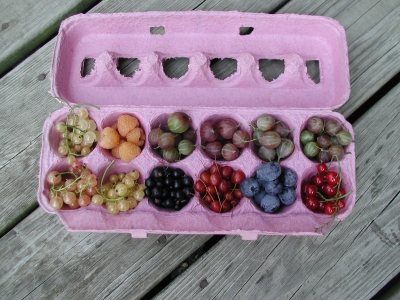
How did all these fruits ever survive in the wild? They did so by not growing here — in the wild. Apples, peaches, cherries — most of our familiar fruits — were never wild here, but come from climates with more equable temperatures, mostly eastern Europe and western Asia. We favor them because they are part of our mostly European heritage.
The fruits that I never worry about here are the few that are native: pawpaw, persimmon, grape, mulberry, lingonberry, and blueberry, to name a few. (Also raspberry, gooseberry, and currants, cultivated varieties of which are hybrids of native and European species.) After decades of fruit growing, I’ve hardly missed a harvest, no matter what the weather, from any of these native fruits. (I cover native, non-native, common, and uncommon fruits in my books Uncommon Fruits for Every Garden and Grow Fruit Naturally.)
 Still, I can’t deny the delicious flavor of apples, peaches, and other non-native fruits, especially those I grow myself. So I do grow them, do what I can for them, and hope for the best. I may even put a thin coat of white kaolin spray on these trees to reflect the sun’s warmth and further delay awakening of the buds.
Still, I can’t deny the delicious flavor of apples, peaches, and other non-native fruits, especially those I grow myself. So I do grow them, do what I can for them, and hope for the best. I may even put a thin coat of white kaolin spray on these trees to reflect the sun’s warmth and further delay awakening of the buds.
Last year was a very poor year for many tree fruits, and I’m not sure why. (Recovery from the previous years cicada attacks could be part of the reason.) Nonetheless, every year about this time I’m bursting with optimism for a bountiful fruit harvest.
Veggies, As Usual, Chugging Along Nicely
I consider vegetables relatively easy to grow because most are annuals and because, with most of them, I can sow and harvest repeatedly throughout the growing season. Let cold or some pest snuff them out, and I can just replant.
The first of my lettuces, sown early last month in little seed trays, are up and growing strongly, each seedling transplanted into its own APS cell (available from www.gardeners.com). Ninety-six seedlings take up little more than a couple of square feet and, with capillary watering from a reservoir beneath the APS trays, I need check the water only about every week.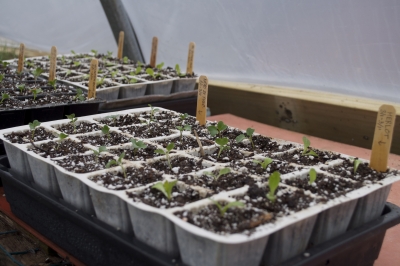
My next wave of indoor seed-sowing will take place in the middle of this month. That’s when I’ll sprinkle pepper, eggplant, broccoli, Brussels sprouts, kale, and cabbage seeds into the miniature furrows of miniature fields of my seed flats.
I’ll also sow another batch of lettuce seeds indoors, this batch for eventual transplanting outdoors. The first batch is soon to be transplanted into greenhouse beds.
Fig Prophylaxis
Buds on fig trees planted in the ground in the greenhouse are showing hints of green and swelling ever so slightly in spite of the cool night temperatures in there. The scale insects that I battled last year are undoubtedly also coming to life on those plants. In the past, I’ve kept these insects at bay by scrubbing the bark in winter with soapy water or by spraying it with insecticidal soap, or, during the growing season, wrapping the trunk with a sticky Tanglefoot barrier to stop travel of ants that herd the insects.
I’ve never gotten rid of scale insects, only kept them from gaining the upper hand. And some years it’s been a neck and neck race as to who would win out before the end of the season.
 I’ve already begun this season with prophylactic sprays of oil. Oil has a long history of controlling insects and some diseases, with the advantage of causing little collateral damage to the environment, including beneficial insects. Because it’s main effect is to clog insect breathing ports (spiracles), there’s little danger of insects developing resistance.
I’ve already begun this season with prophylactic sprays of oil. Oil has a long history of controlling insects and some diseases, with the advantage of causing little collateral damage to the environment, including beneficial insects. Because it’s main effect is to clog insect breathing ports (spiracles), there’s little danger of insects developing resistance.
Oil’s major hazard is its potential to injure plants, mitigated by spraying when temperatures aren’t too hot or below freezing, or when rain is likely, all easily avoided in a greenhouse. Various kinds and formulations of oil — kinds include vegetable, mineral, and neem oils — differ in their hazard to plants. I’m using a high-purity mineral oil (Sunspray) from which I expect no damage, especially since the plants are still leafless.
Scale insect eggs should be hatching about now. Brutal as it may sound, I hope to suffocate the crawlers before they settle down to one spot to cover themselves with their protective armor and literally suck the life from the plants. Weekly sprays should cover successive hatches.
New Video
Check out my new video on “pricking out” seedlings!
Free Book!
Book giveaway! Write a comment here telling us which is the most difficult fruit you grow, and why, and why you grow it, and you’ll be entered in a drawing to get a free copy of my most recent book Grow Fruit Naturally. Comments must be submitted no later than noon, March 23rd.
Upcoming Lectures
Check out the “Lectures” page of my website for some lectures I’ll be giving in the next few weeks.

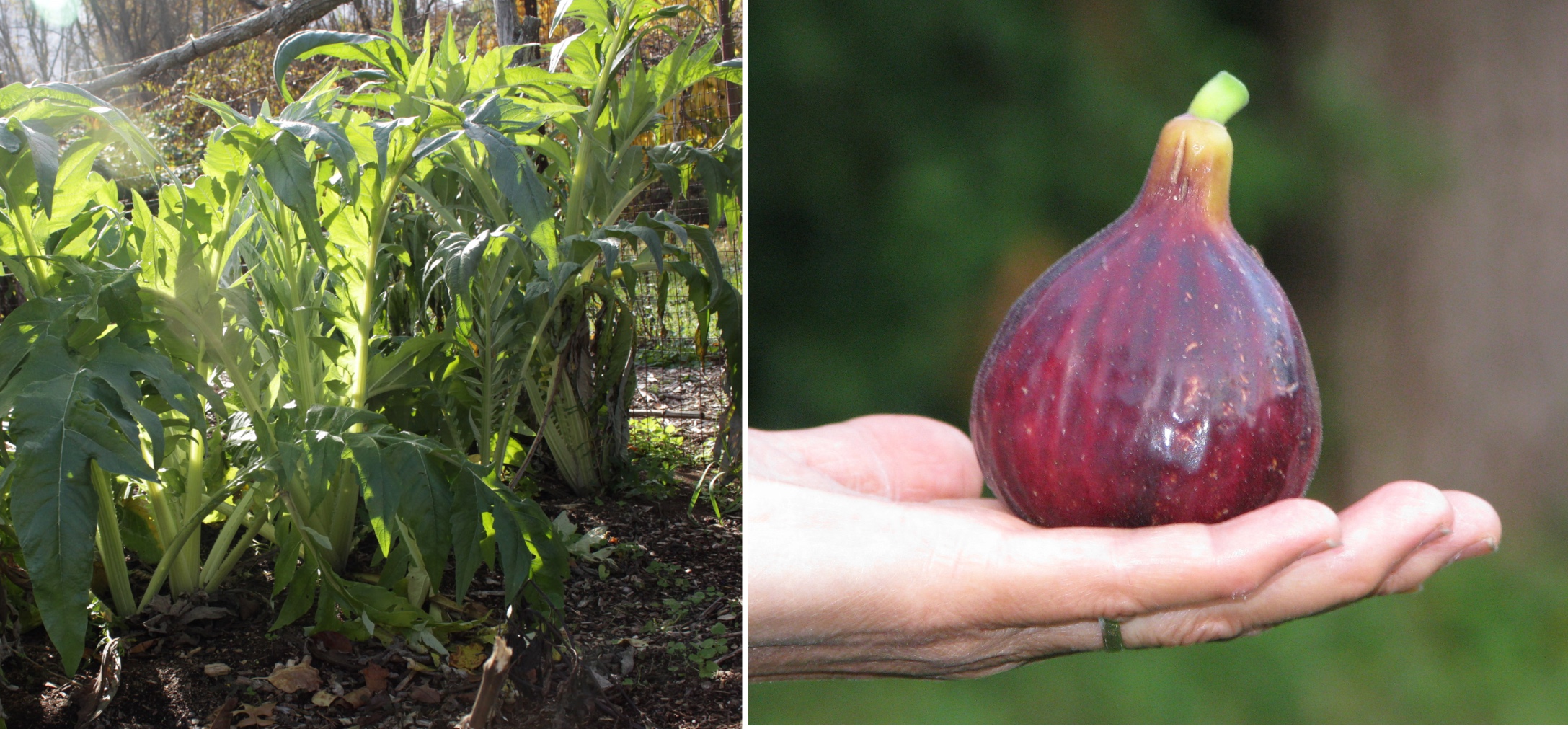
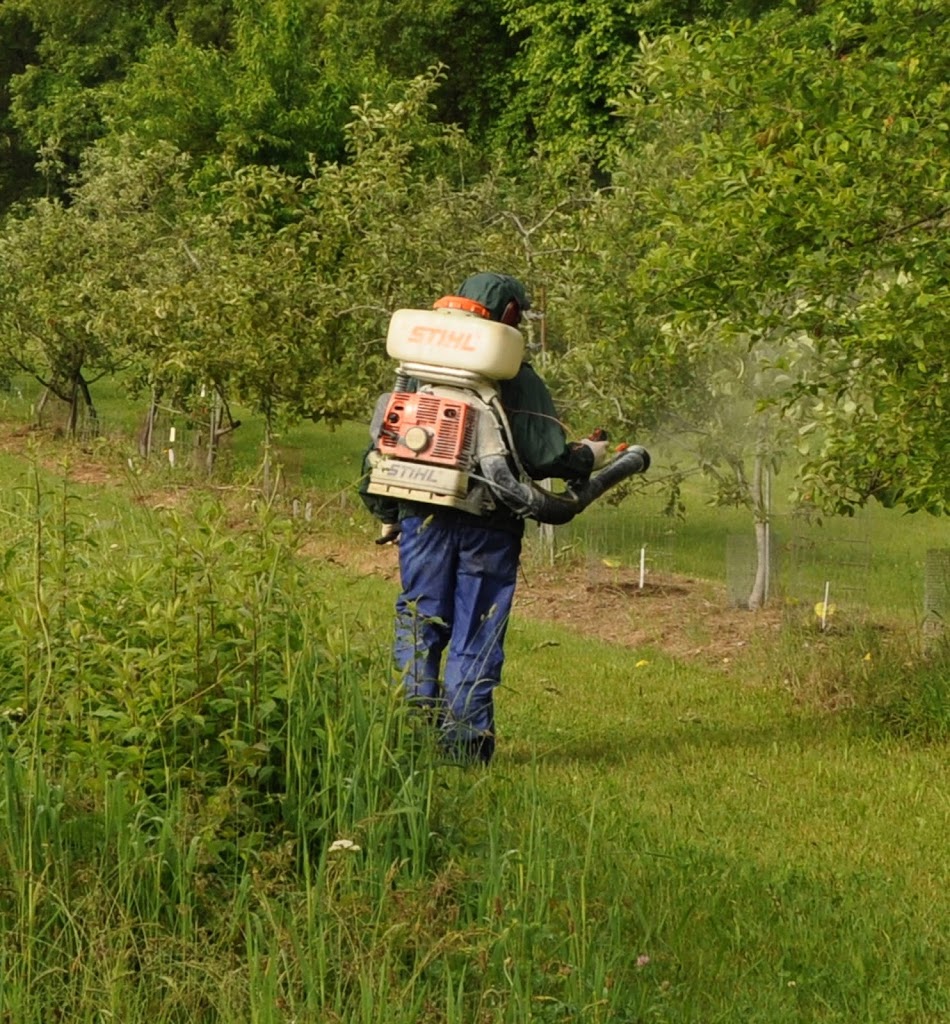
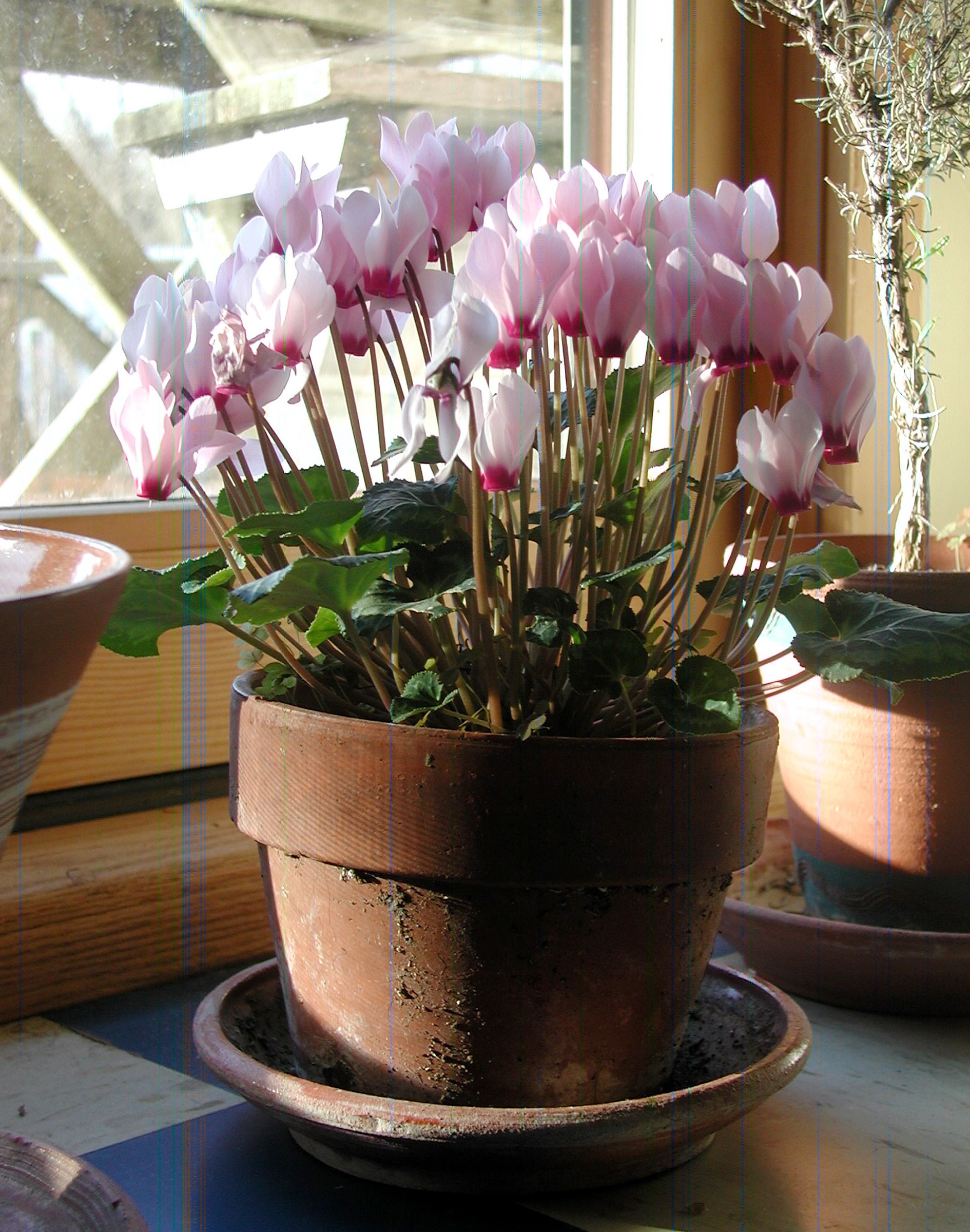

Peaches, because they taste like the sun. My small city property with southern exposure is in an area that is likely a frost pocket, but I tried planting them anyway. This year, the plan is to plant in large containers which will be rolled to the shady (northern) backyard for the winter. I have no idea if this will work but I keep trying!
Hardy kiwi and Pawpaws for me, and its not nessesarly difficult to grow. Just difficult to wait all theses years!!!!
Why? Because they are rare and taste amazing!
Happy growing
“which is the most difficult fruit you grow, and why, and why you grow it”
I’d have to say the most difficult fruit I’ve grown is Mulberry. The fruit is easy enough to come by, but the unwanted mulberry tree weeds that end up throughout my property provide plenty of headache! 🙂 But I’ve got a tree with good flavor (less musky than is typical), and the chickens love the treats as well.
My parents would put some of your “foreign-origin” fruit trees (i.e. apples and peaches) on their not so difficult list, but that’s because they keep their expectations low. The orchard gets minimal care, and when there is a harvest, they pick what they enjoy, and leave leftovers to the neighbors (human or otherwise). Thinking of the trees as halfway between a domesticated-thing-to-care-for and a wild-thing-to-gather-from works well for what they want.
The only fruit I grow is strawberries right now, which I love, and the difficulty only comes from trying to beat my 7 year olds to at least some of the crop!
Blueberries are the most difficult to grow for me because you have to have the soil acidic and just right.
Just planted honeycrisp apples 2 years ago. Squirrels got the few fruits that emerged last year, hoping for a first real harvest this year.
My most difficult fruit is probably apples, although I can’t tell whether they’re really that hard or whether it’s just hard to wait for them to bear on our young homestead. We’ve had trouble so far with waterlogged soil, cedar apple rust, and voles, but hope we’ve got all of that licked with variety selection and a better site. We keep gnawing away at the issue because we want to have a fruit we can easily store in fresh form in the winter.
I know this sounds silly but I have the hardest time with goji berry shrubs. I have moved the shrubs around to different places in my garden but I can’t figure out what it prefers to thrive in my No.Va. zone 7 garden.
Hmmm…we are in northeast Texas zone 7b or something like that and Goji have taken off for us when other plants have needed much more care. They like full sun and neutral soil. Ours is sandy. The bushes we ordered came as tiny sticks and we didn’t have much hope for them. How exciting it was to harvest a few berries the very next summer!
Figs….because I love Fig Newtons. And the challenge to grow them in Snohomish, WA
My most difficult fruit to grow continues to be the fig. After moving to Roanoke Va in 2000 I have had unusual winter conditions kill my tree one year and severely damage it another. And yet other years that seem just as bad have no damage. I grow fig primarily because we just love figs and the fig jam is considered gold in our family.
I grow veggies but I’ve always been afraid to try fruit (and I don’t have the space) BUT…this is the year I’m taking the plunge to try blueberries (in containers) and currants. Here’s hoping!
I am just beginning my fruit growing journey but right now apples are giving me trouble! The last couple years a mystery guest has been drilling into the tight little buds and taking a bite out of the center. It is a small espalier so there are not many buds to spare. This year I am determined to find the culprit!
You – and St. Lawrence Nurseries – inspired me plant currants and gooseberries and a bush cherry tree to keep my rhubarb, blueberries and alpine strawberries company in two small sunny beds I have in front of my house (right on the street). I have had the most difficulty with the three blueberry plants. They grow and produce some berries but are not really thriving despite applications of compost, HollyTone, pine needles, etc. Everything else is quite happy and undemanding (especially, of course, the rhubarb!). Thanks for all your guidance and color photos! Another note – still fairly perplexed about pruning these various plants.
The most difficult fruit I grow has to be my Meyer lemon and key lime. They pose the same level of effort as other fruit I grow-scale and leaf drop are an annual event in our zone 6 winter. They can be more difficult because they can suffer from too much attention from a gardener champing at the bit for spring to arrive. The amount of time spent watching buds move from flower to almost imperceptibly slow swelling ovaries verges on the voyeurism. But I grow them in my sunniest window for just that reason; it’s so hopeful to watch the snow fall with the distinct smell of citrus blooms and fruit hanging in it’s infancy in the foreground. They remind me of things yet to come.
All of them, we just moved to a new home and we have nothing. So I will be starting everything from seed or bare roots. Grapes, peaches, strawberries, apple trees and not to mention the raised beds, the garden, flower beds. We don’t even have grass, ect. I have about three acres of vacant, cleared land and we would like to be self sustaining someday!
I don’t grow many fruits yet but probably raspberries are the hardest so far. I suspect they need more sun than where I put them, and also the chickens grab them before I do despite the cage I put around them!
That’s interesting – using kaolin spray to delay budding – I’ve only ever thought of using it to help deal with the plum curculio. We had no fruit last year from either our plum or cherry – I’m thinking our excessively cold winter in Southern Ontario killed the fruiting spurs. I was hoping for some wonderful fruit this year, but once again, we had record lows in February. At this point, I’m just hoping that my trees survived. I would enter to win a copy of your book, if I didn’t already own one! I’m adding several trees & berry bushes this year – it’s a fabulous book and has really helped me with my planning.
Embarrassed to say I have only had experience with berries. I have one grape but have not done well with that. I plan on buying a peach tree this spring. Oh, and I have had a lot of luck with Figs in my Zone 6 area.
Strawberries probably. Never seem to get a yield that seems “worthwhile” plus so hard to keep weeded.
Apples are the most difficult thing for me to grow here in TN. If it’s not a late frost that gets the blossoms, it’s something else. Recently summers have been so rainy and humid that the main problem seems to be fungal diseases. Sometimes the trees set fruit and then the fruit just falls off. Sometimes the tiny fruits turn black first.
Strawberries have been the hardest for us to grow, because we started with too big of a patch and couldn’t keep up with the weeds. We grew them because we like strawberries and wanted to become more self-sufficient in fruit. If I grew them again I would figure the cost of some kind of mulch in the equation.
So far, our elderberry tree is the most challenging because we haven’t yet thwarted the deer, and it’s still a baby tree. Why? my small son tagged along to a local herb league meeting and loved the elderberry juice samples.
I absolutely love fresh peaches — but every time I get a tree started, we get an especially cold winter and it dies out. And store bought peaches aren’t even close to tree-ripened.
My loquats form and then drop off every year. So frustrating!
Sweet cherries are the toughest for us. The Japanese beetles here can defoliate a young tree in a day. A clay spray works but, if you are too late or too early, the tree is toast. Then there are all of the diseases to contend with …
We’re new residents in Louisiana after living overseas for 40 years. Three years ago, we planted a satsuma tree after we bought our home only to discover too late that the shoots growing out from the bottom needed to be trimmed back. Alas, our tree died, but we planted another late last year. Satsuma has a sentimental value for us as my cousin has one in her yard, so hopefully we learned from past mistakes and will be successful this time. Hope springs eternal for the gardener! 😀
Blueberries have given me a hard time. Why? I have no idea. I thought I did everything right researched varieties, planted in nice loam and fertilized with cottonseed meal. Oh and raspberries because of the newly intraduced fruit fly that goes after ripe fruit and turns the berries to mush.
Living in a mild Mediterranean climate my biggest challenge is, during the winter, putting enough ice cubes on my 2 cherry trees so they’ll reward me with their unbelievably luscious fruit.
Why ice cubes?
I’d be better off answering which are the easiest so far: raspberries, blackberries and strawberries. Thank goodness, since they’re all favorites of mine.
Most difficult: anything that grows on a tree. The voles killed the apricot, something else munched the peach tree; the new septic system killed the cherry and the two apples seem to be just languishing back there – black spot from the crabapple tree maybe? I persist because I love a challenge and I love fruit!
We inherited a very old apple tree in the front yard of our house. The fruit is completely inedible (I’ve tried everything), becomes a daily nuisance to pick up mid-summer onwards and the tree also has black rot. We keep it though because of its large size, unusual shape, the shade it provides and its beautiful spring blossoms.
Strawberries….because chickens.
Because that fence they respect all year long majikly fails the day the strawberries ripen.
The most difficult ones are definitely peaches. I love peaches but find the shop bought ones boring, so keep trying to grow my own. The tree flowers its socks off, makes lots of little peaches that then fail to grow any larger than a table tennis ball, even with me painfully picking many off so that the tree does not have too many to handle. And I just don’t get these special peach/nectarine pruning rules.
Apricots. We are not very far North, but in a valley at fairly high elevation. They are blooming now, but I’m not counting the fruits yet–we still have a month and a half before our average frost-free date! We have just enough of a chance each year to get tricked into growing these incredible fruits. I’m like Charlie Brown winding up to kick the football while Lucy holds it!
Peaches I can have a good crop one year and the next is a mess.
Serviceberry is tough for me. I love the flavor, and the look of the tree, but cedar-apple rust has been robbing me of my prized fruit…
The hardest fruit that I grow are plums. Let me be clear. The trees grow and bloom beautifully, but I never get any fruit because of the the dreaded plum curculio. After petal fall, they move in and sting EACH fruitlet causing a dripping crescent shaped scar which typically causes the fruitlet to abort. I hope that one season, the tremendous bloom on my American hybrid plums will vastly outcompete the curculio’s capacity to sting each one. Until then, I enjoy their white blossoms and grape cough syrup odor. I’ve had juicy plums picked right off the tree and that keeps me hopeful. Kahinta, Toka, LaCrescent, etc.
I’m pretty new to growing fruit, so right now I’m not sure which fruit is the hardest for me to grow – I’ll have to comment back at the end of the summer!
So far, we have two sour cherry trees (produced a handful of cherries last summer, planted in 2013), three blueberry bushes (just planted last year), a blackberry bush (also planted last year), and some strawberry plants. I’m excited to see what the future brings with growing these fruits and hope things go well. I think what I want to succeed the most is the blueberries. My family and I love blueberries and they are so good for you too.
Thanks for the information you have here, Lee, and thank you for the giveaway!
Tammy
I grow strawberries and every year have to replant. I live in the high desert and the hot sun really takes a toll on the berries every year. The winters can be dry with high drying winds to kill off the berries that survived the summer. But, even so, I cannot resist planting the beautiful succulent red berries. The aroma of fresh berries makes your mouth water! There is nothing more gratifying than heading out to the garden at dawn on a summer’s day, cereal bowl in hand, to pick a few succulent strawberries.
I’ve had nothing but failure from apples, but keep planting them because I can’t resist the espalier trees sold at the big box store in spring when hopes are high. I justify the purchases since they come from a local grower. This year I’ve already purchased 2 of the columnar apple trees.
Cherries–I wait for them to ripen and when its time, the birds get them before I get a chance to pick
To me, there’s not much better than a sun-ripened peach. I live about 3000 feet up in the Southern Appalachian Mountains, though, and it seems that more often than not, a few warm days in early spring will get the peach trees a-blooming just in time to be frozen solid by an untimely cold snap. Then we get zero fruit set and no harvest at all. A few times my wife and I have fought against all odds to save our peaches from a frost–draping every sheet and blanket we could find over our tree’s canopy and placing buckets of hot water all around the trunk through the night. Sometimes this has actually worked! It’s not easy to grow peaches here, but they’re so darn good, we can’t stop trying.
I would say that the hardest fruit I have grown is gooseberry. I live in zone 6 so the heat and the sun just don’t seem to agree with my plants. Have you heard of any gooseberry cultivars that both taste good and do well in the heat?
Thanks for doing the giveaway!
Glendale supposedly does better in warmer areas. Another possibility is to plant in part shade or on north facing slope. Mulch also. I grew gooseberries successfully in Maryland, near College Park, many years ago.
I planted my first fruit bushes last fall – blueberries! Even if they don’t fruit well or all the birds get them, I know I’ll have beautiful red leaves in the fall, but I’m still hoping for a bit of a bounty. I would love to plant more fruit, so your book looks wonderful. Thanks for the giveaway!
I live in zone 6 Utah. Apples and peaches are easy here, as well as most berries (except blueberries). My struggles are with my hardy kiwi and maypop vines. They are on their fourth year now and are still quite small and haven’t produced any fruit yet, though the maypop flowers a little, so I still have hope. Another hard one for me is pomegranate, since my winter is too cold for it, but it’s surviving, nestled up to my house to stay warm enough in winter. I do it for the fruit! I want to plant as many different types of fruit as I can. I’d like to not need the produce section of the grocery store.
Elderberries. Shouldn’t be the case, but I have yet to get fruit on the three black lace variety I planted a couple years ago … And they are scrawny. I’ve discovered I may need another type to pollinate and hope to see if that works this year.
Pommelo. I’m still working out the right combination of feeding and watering to get sweet fruit. I’m a little too close to the ocean for the heat they really want, but the fruit is worth every painstaking experiment I try on it. (This year: early feed, more water, and then another feed as the fruit is growing out. I’m getting there.)
Blueberries have failed me over and over. This time I’m going to try growing it in a container. Easiest to grow (so far) are golden raspberries. I’m still waiting on all the various bare root stone fruit trees we planted last year to get ’round to producing something. Thanks!
Well it’s past the contest, but I wanted to comment anyway. Growing a fruit type for the first time is difficult. Every year I try to pick a strange fruit to grow. Last year it was Tzimbalo. I guess they require a long season. I had well over 800 fruits, but they were not quite ripe and tasted pretty bad. I didn’t save seed, although I probably should have. I composted the fruit, I could not make it edible. This year it’s the Sherbet berry. See how that goes…
Zone pushing fruits can be hard to grow. I grow blueberries but I wanted to grow this Southern Highbush here in Michigan. I’m in zone 6, but it is more like zone 4! Last winter the lowest temp was -16F. All my peach trees look like for a 2nd year to lost all fruit buds to the cold. Anyway Sweetcrisp blueberry rated to zone 7. It has very wispy foliage, weak and thin for a blueberry. But the name says it all it is sweet and almost as crisp as an apple. No other blueberry is anything like it. Well now Indigocrisp has been released to commercial growers only. So I bought one last year and for the first time overwintered plants in my unheated but attached garage. The plant did fine even with the sub zero temps. I pruned it hard so no chance of fruit this year. I’m trying to thicken up the weak canes! It looks to be budding out they are ever so small right now. Most of my trees have no bud swell yet, so all is normal. What’s hard is pruning for a healthier plant and having to wait another year even to taste this very unusual blueberry!
I am in Jersey City and have a Hachiya persimmon tree. It starts out great in the spring, but have so much fruit fall that I usually end up with 3-4 persimmons.
Have read that you know a lot about persimmon trees; which of your books will help me solve he fruit fall problem?
Thank you..
“Uncommon Fruits for Every Garden” Perhaps the tree needs a pollinator variety nearby for best fruit production.